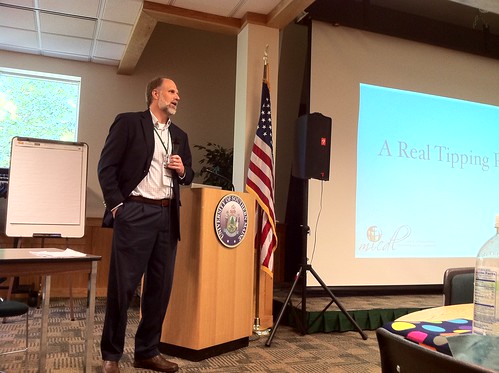These are my notes from John Newlin’s presentation, “A Real Tipping Point?” at the September 27, 2011, Google Geo-Teacher Institute in Lewiston, Maine. MY THOUGHTS AND COMMENTS ARE IN ALL CAPS. John’s conference bio is:
John Newlin, Executive Director of the Maine International Center for Digital Learning, has served as a high school teacher, district curriculum coordinator, and school reform coach. Beginning in 2006, he also served as the project director for the nation’s first multi-district federal Smaller Learning Communities (SLC) grant, during which he co-designed and co-facilitated numerous 3-day professional development courses on integrating digital technologies into instruction using a collaborative action research model.
I’ve been doing school reform support work for many years
– I’ve concluded the pace of change happening through my approach wasn’t satisfying to me
– I moved in the direction of digital technologies as a result, connected with Bette Manchester
Maine International Center for Digital Learning
– independent non-profit founded in 2008
– we are not part of the state’s system
– we believe what has been going in Maine has been great
– lots of opportunities to provide support and synergy as we continue to move forward
From the MICDL about page:
MICDL is a non-profit organization that provides professional development and support for middle and high school leaders and teachers (both in-service and pre-service) regarding student-centered learning and teaching practices in 1-to-1 digital environments for the purpose of fostering student creativity, engagement, empowerment, well-being, and readiness for citizenship, college, and careers in a rapidly changing global society. MICDL also identifies, uses, conducts, and disseminates collaborative action research and formal research, and supports the development of local, state, national and international policies and practices in the field of digital learning and teaching.
Our focus is individualized and community-connected learning
– we want people to ask “what is community connected learning?”
– this is placed-based learning, community-based learning
– making connections with the real world to make learning richer / more engaging
– we want students to have a strong sense of community when they are IN school as well as out
This isn’t FOR digital learning, we are FOR individual learning combined with community connected learning
MY THOUGHT: THIS IS AN IMPORTANT DISTINCTION AND DEFINITELY NOT SOMETHING I HEAR A LOT WHEN FOLKS TALK ABOUT 1:1
What’s the ultimate in individualized learning?
– tutoring with Socrates?
– self-directed
When my own kids have worked with tutors in the past, the acceleration of their own learning has been phenomenal
John showing The light brigade – scene from “The blind side” (YouTube clip)
Tagging, Tracking and Targeting – for Learning
– potential risks: invasion of privacy, excessive focus on the individual student
What about using these technologies to enhance the learning process?
Carpe Diem Schools (Yuma, AZ)
Carp Diem isn’t the only school looking at this model, Flex Academy in San Francisco is also doing this
If you enjoyed this post and found it useful, subscribe to Wes’ free newsletter. Check out Wes’ video tutorial library, “Playing with Media.” Information about more ways to learn with Dr. Wesley Fryer are available on wesfryer.com/after.
On this day..
- First HAM Radio Club Meeting – 2022
- Deepening our Learning Through Storytelling: creativity, STEM and stories – 2011
- Google SketchUp Workshop (Sept 2011) – 2011
- This is a big map! (Giant Traveling Maps from National Geographic) – 2011
- The Fourth Part of the World by Toby Lester – 2011
- Giant Traveling Maps project from National Geographic – 2011
- Google in Education and Chromebooks (Sept 2011) – 2011
- Digitizing Student Portfolios with an iPod Touch – 2011
- iCarly inspires The Zebra Print – 2010
- Sticking with Free Ad-Supported SMS Alerts for Class – 2010

